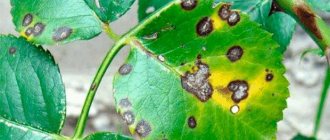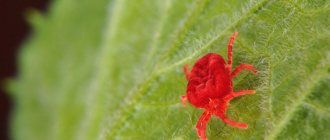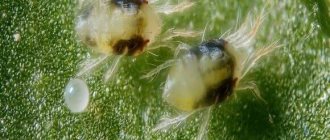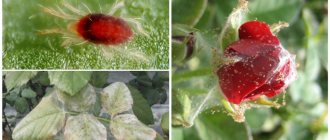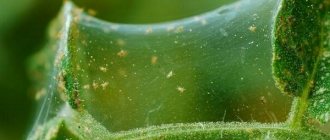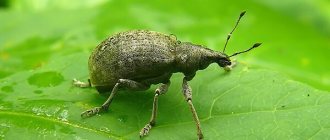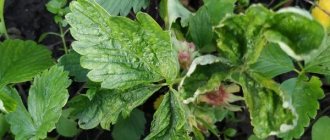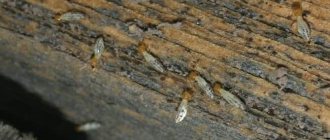Soap solution Alcohol solution Garlic Onion Decoctions and herbal infusions Rosemary essential oil
Spider mites are small insects, but they cause enormous harm . Loves high temperatures and low humidity. Feels great on indoor plants and in greenhouses. Mites feed on the cell sap of leaves , which leads to their yellowing, death and death of the plant.
It is very difficult to see such a mite ; cobwebs appear on the leaves already at a late stage of infection.
Description of the pest
Spider mites are arthropods from the class of arachnids, up to 1 mm in size.
A single adult insect is difficult to notice with the naked eye. The color is protective, light green, reddish or yellowish-brown. The body of the mite is covered with tiny bristles necessary for touch; at the ends of the legs there are claws with which the spider clings to leaves.
Females are larger than males, their bodies are more rounded. Ticks are very prolific: an adult lays 5-7 eggs per day, attaching them to the underside of leaves. The masonry can easily withstand rising and falling temperatures, wind, precipitation, and hot sun. From eggs laid in late autumn, with the onset of warmer weather, a new generation of arthropods hatches.
Pests begin to actively reproduce in June, and their number reaches its maximum in July and early August. Towards the end of summer, spider mites begin to hibernate, but if the warm season drags on, activity may continue. Arthropods overwinter in the upper layers of the soil, uncut growth, and cracks in the bark of trees. Sometimes they penetrate into outbuildings or houses, hiding in all sorts of cracks.
There are many types of spider mites. Some of them prefer certain plants. For example, the red fruit mite affects apple and plum trees, the hawthorn mite affects roses, ornamental and berry bushes.
In the middle zone, the common tick is especially common. The pest is almost omnivorous; after appearing on one plant, it takes over the entire area within a season. Small mites are carried with soil particles on shoes, clothes, garden tools, and remain on weeded weeds or pruned tree branches.
Common types of spider mites
Among spider mites, there are several main types that damage vegetation growing on a windowsill or in an open garden bed:
- Ordinary. Its diet includes a variety of vegetation. It affects crops in both open and closed ground.
- Red. Affects flower beds, vegetables, and grain crops. It can cause harm both in open ground (warm regions) and indoors (in the north).
- Atlantic. Found everywhere. Its main target of damage is cucumbers.
- Bean. Its diet consists mainly of legumes. It is usually found in the Far East.
- Turkestan. This pest feeds on various vegetables, as well as ornamental plants.
The listed species are only a small fraction of the 1,270 species of this pest found in nature. However, the methods of dealing with each of them are not much different.
Why is it dangerous?
Spider mites are herbivorous arachnids.
Their main food is cell sap, which they suck out through numerous punctures on the leaves. The affected leaves dry out and fall off, the plant cannot develop normally, form buds and fruit ovaries.
Moving from one plant to another, mites carry dangerous viruses, fungi, and bacteria. Arachnids are not capable of flying, but are easily transported by the wind along with cobwebs. After overwintering, the pests quickly restore the population and can completely destroy the crop.
Symptoms of plant damage
The following signs of mite damage to plants are distinguished:
- Brown spots that look like holes made with a needle.
- Yellow or light green dots.
- Falling flowers and leaves.
- Slow plant growth.
- Silvery webs between the leaves.
- The presence of small insects on the underside of foliage that look like red or yellow moving dots.
- A large number of mites on the web is a sign of a large mite infestation.
- The presence of black grains that are easily separated from the plant - mite excrement.
The spider parasite loves greenhouse crops with thick, fleshy leaves. Plants such as ficus, hibiscus, and fuchsia are most susceptible to its attacks.
How to find out about plant infestation
The first sign of a tick appearance is light spots on the leaves remaining at the puncture site.
Gradually there are more and more of them, the dots merge into large whitish or reddish spots. The leaves take on an ugly shape, dry out and fall off. At this time, you can notice thin threads entangling the leaves and stems of plants. With severe lesions, the amount of cobwebs increases.
Spider mites prefer juicy young greens rich in chlorophyll. In spring, pests appear on weeds: quinoa, plantain, coltsfoot, and nettle.
Gradually, mites move to cultivated plants: flowers, fruit trees and shrubs, berry fields. You can notice their presence in mid-summer: at this time the colony of pests increases significantly.
The following plants are especially affected by spider mites:
- garden strawberries;
- gooseberry;
- currant;
- raspberries;
- apple trees;
- pears;
- tomatoes;
- cucumbers;
- melons;
- eggplant;
- pepper;
- beans.
Pests often attack flower beds and balcony boxes. They can be seen on asters, roses, marigolds, saffron, and petunias. Mites enter the house with cut flowers and pose a danger to all indoor plants.
You need to know the enemy by sight
Spider mites (or scientifically in Latin - Tetranychidae) are distributed throughout our globe. But given their vitality, it is possible that beyond its borders J. Even in the ice of Antarctica, larvae of these insects were found. The species diversity of spider mites is simply amazing; there are more than 12 hundred different species.
This is what a spider mite looks like when zoomed in
The size of this pest is so small (less than one millimeter) that it is almost impossible to see it with the naked eye. The appearance of spider mites on indoor plants can only be detected when insect colonies reach impressive sizes. And also as a characteristic feature - the appearance of cobwebs near the leaf cuttings and at the bottom of the leaf.
This is what spider mite larvae look like
Mites feed on plant juices, located on the underside of the leaf blade, closer to the large veins. Spider mite , like forest mites, has a sharp proboscis, with which it pierces the leaf tissue and drinks the juice. As a result of the activity of a colony of pests, the plant begins to quickly wither, rapidly lose leaves and, ultimately, dies if timely measures are not taken.
And on this leaf you can see the spider mite itself, its larvae and the eggs it lays.
The lifespan of a tick is less than two months, but females manage to lay up to five thousand eggs during this time, from which a new generation of ticks emerges every 2-3 days. Therefore, the pest population is growing almost at lightning speed.
And this is what a leaf affected by spider mites looks like, but without magnification
In addition, spider mite eggs are able to wait out unfavorable periods in a state of suspended animation. They remain viable for up to 5 years!
How to fight
Spider mite activity peaks in mid to late summer. The hotter and drier the weather, the faster pests spread. You need to start with preventive measures; strong chemicals are indicated for extensive lesions.
From the beginning of summer, it is important to carefully inspect the plantings, looking under the leaves, paying attention to the speed of plant development. Particular attention should be paid to greenhouses and greenhouses: in a confined space with a consistently high temperature, pests multiply more actively.
The earlier the problem is noticed, the less effort will have to be spent on exterminating the tick.
Rules of agricultural technology
To prevent the site from becoming infected, you need to clear the beds of weeds, fallen branches, and debris in the fall. Trimmed shoots and weeds are burned, and the beds are dug to the maximum depth. Repeated digging is carried out in early spring: it will help get rid of female mites overwintering in the upper layers of the soil.
A prerequisite is timely weeding. Weeds need to be destroyed starting in early spring. Lush greenery attracts ticks, and later they move on to cultivated plants. Regular mowing of grass between rows and on lawns will help reduce the risk of infection.
When the first parasites appear, you need to increase the frequency of watering. Ticks prefer warmth and dryness; humidity above 80% is destructive for them. To create such a microclimate, immediately after watering the beds are covered with film for 2-3 hours.
Infected plants are weeded out and burned to avoid further spread of pests. In between waterings, it is recommended to thoroughly loosen the soil, breaking up the hard crust. A mandatory item is the application of phosphorus fertilizers to the soil. They stimulate the development of the root system and improve plant resistance.
Expert opinion
Mityuk Stefania Bogdanovna
Next to the beds you can plant plants that spider mites do not like, for example, calendula.
Traditional methods
Traditional recipes are recommended in the initial stages, when plants are slightly infected. The compositions are used for washing and spraying, trying to prevent the caustic liquid from getting on the roots.
Experienced gardeners recommend the following recipes:
Grate laundry, boric or tar soap, add water in a ratio of 40 g per 1 liter. Stir until the shavings are completely dissolved, wash the leaves 2 times a week, paying special attention to the underside. This composition is especially good for removing mites from cucumbers, peppers, and tomatoes.
1-2 tbsp. l. Dilute ammonia in 10 liters of warm water. Stir and spray the affected plants 1-2 times a week, being careful not to let the liquid get on the roots. For greater effectiveness, you can add a little grated boron or tar soap.
Cut 800 g of yarrow stems and flowers, pour in 2 liters of warm water, leave for 1 hour under the lid. Strain the infusion, add another 8 liters of water, stir. Use for spraying plantings for preventive purposes.
Dissolve 30 g of wood ash in 1 liter of hot water, leave for 1 hour, strain, add 20 g of grated laundry soap. Use for washing or spraying the lower part of the leaves.
Grind 600 g of dandelion leaves or 400 g of roots, pour in 10 liters of warm water, leave for 1 hour. Strain and generously spray the affected plants. After 2 weeks, repeat the procedure.
Peel the head of garlic, cut the cloves and pour 10 liters of hot water. Leave for 5-6 hours, strain, spray the plants, making sure that the liquid covers each leaf.
Chop 1 kg of horseradish root, add 2 liters of warm water, leave for 1-2 hours. Strain, add another 8 liters. water. Spray the plants at least once a week.
Plant materials used to prepare decoctions must be clean and free from pests. If spider mites have already been noticed on the site, the plantings should be treated once a week; for prevention, the plants are sprayed 2 times a month. Before processing, it is recommended to water the plantings well. The optimal time for procedures is a warm evening or morning.
Despite the fact that folk remedies are considered completely safe, you need to be careful when working with them. For example, when treating a plant with a solution of ammonia, it is important to protect the respiratory system with a mask or respirator. When preparing infusions, the recommended concentration must be observed: some plants can cause leaf burns.
Acaricides and insectoacaricides
In case of severe infestations, it is worth switching to more effective means that can quickly destroy large colonies of pests. To combat different types of ticks, special means have been created - acaricides. There are also insectoacaricides that act on both ticks and other types of pests: whiteflies, thrips, aphids, and Colorado potato beetles. The preparations are suitable for different types of plants, have a prolonged effect and are not washed off during rain.
What spider mite treatments do you use?
FolkChemical
When purchasing an insectoacaricide, you need to clarify the degree of its toxicity. The safest products are those marked “4”; they do not accumulate in the soil and do not harm animals and agricultural insects. These preparations can be used in greenhouses, on verandas and in residential buildings.
Preparations marked “2” can be dangerous for birds and are destructive for bees and inhabitants of water bodies. When working with such products, protection is required: gloves and a respirator.
Compositions marked with the number “1” are not suitable for gardens and vegetable gardens; they are used in warehouses.
Gardeners include the most effective preparations:
A hormonal drug based on clofentesine, packaged in ampoules, bottles and canisters, diluted with water before use. Effective against larvae and egg laying, prevents population increase. Slightly toxic, can be used on any plants no later than 3 days before harvest.
Emulsion based on malathion, which has a paralyzing effect on spider mites. The effect occurs a few hours after treatment, the protection lasts for 15 days. Toxicity is moderate, dangerous for bees. Can be used for all types of plants: flowers, fruit trees and shrubs, berry gardens.
A potent pesticide that quickly destroys adult ticks and some larvae. It has little effect on eggs. It is better to treat plantings in series, as new insects hatch. After spraying, the solution protects the plantings for at least 3 weeks. The drug is dangerous for bees.
A slightly toxic drug, the main active ingredient is flufenzine. The suspension is diluted with water and used for spraying. Very economical, a small package lasts for the whole season. Protects plants for 1-1.5 months, quickly destroys mite eggs and larvae.
Low toxic suspension for repeated use. Destroys parasites at all stages of development, has a sterilizing effect on eggs. The drug is economical and safe for birds and insects. Suitable for treating berry and flower beds throughout the season.
Inexpensive drug made in Russia. It is a biological insecticide, destroys larvae and adults, and is effective against ticks and whiteflies. Recommended for treating flower beds and vegetable beds. May be dangerous to insects and birds.
What do doctors advise for prevention?
Wash your hands and maintain social distancing. Yes, these rules work not only with Covid-19, but also with seasonal ARVI.
Correct work-sleep-rest regime. Are you getting enough sleep, are you not overtired, and are you not under too much stress? This means you are less likely to get sick.
When we are indoors with other people, we are more likely to be exposed to germs. Organize comfortable temperature conditions, constantly ventilate the room and monitor the operation of the batteries.
People who exercise regularly have a lower risk of contracting a viral infection because physical activity strengthens the immune system. Even a small but regular load will do.
Folk remedies in the fight against spider mites. My processing scheme.
Those who, like me, were looking for other ways to fight, I think more than once saw recipes against spider mites based on laundry soap, onion peels, garlic or even dandelion.
You should not be skeptical about these methods, since they help many people quite well, and my scheme is based on one of the above components.
Let me remind you that chemistry is not an option for me at all, and I was ready to do anything just to avoid poisoning myself and my household with it. Therefore, at first, I tried to follow the advice from the forums and, having treated the plants with a soap solution, wrapped them in a bag for several days (so that the solution would work), but after such treatment the mites came out again. It was stupid to hope that I would get them out the first time, but I still wanted to believe.
I won’t write to you about my torment and different options; I’ll probably move on to the scheme that I arrived at through trial and error.
There are quite a lot of plants in my collection, so I had to ask for help in selling it.
All you need is laundry soap, water and a soft sponge. No packages needed!
- Transfer infected plants to the bath.
- Be sure to remove and wash the curtains, because... they come into contact with infected plants and may also harbor these pests.
Disinfection of planting material using garlic
Using garlic infusions, you can sanitize planting material. Experienced gardeners who grow garden strawberries for sale often practice this method:
- 150 ml of universal concentrate is diluted in a bucket of water;
- garden strawberry bushes are completely immersed, together with leaves, in the solution;
- stand for 20 minutes, lightly dry the planting material under a canopy and plant it in the garden bed.
This method of disinfection with garlic infusion is especially recommended for planting material purchased “outside” - in nurseries, on the market or from neighbors.
Biochemical composition of garlic
The better the garlic is ripe, the more valuable elements it contains. Biochemical analyzes reveal the presence of seventeen mineral elements in garlic cloves: potassium, phosphorus, sulfur, iodine (see → use as a supplement), copper, manganese, etc.
In addition, garlic contains the following components important for the grower:
- Phytoncides. This term refers to substances that can destroy microorganisms. Garlic phytoncides have exceptional activity. Laboratory experiments prove that they kill Koch’s bacillus 6 times faster than the popular antiseptic “carbolic acid” (in 5 minutes versus 30).
- Diallyl disulfide. This substance is an organosulfur compound that gives garlic its specific smell.
In general, there are more than a hundred different sulfur-containing substances in garlic cloves. All summer residents who have at least once used colloidal sulfur on their plots are aware of the benefits of sulfur in the fight against plant diseases and pests. Thus, garlic can be considered a natural substitute for this chemical.
Garlic is not a simple substitute for colloidal sulfur, but an improved one. It contains essential oils and phytoncides, which are not found in the chemical preparation.
Onion peel solution
The folk method, which has helped many generations in the fight against spider mites, is based on its dislike for phytoncides contained in onion peels. 200 g of husk is poured into a bucket of hot water and left for 5 days. Then they strain and spray the beds. Such procedures are repeated at least three times at intervals of a week.
Decoctions
One of the types of folk remedies that are used against spider mites are decoctions that are used to treat plants regularly. To do this, you can use cyclamen roots (50 g per half liter of water), the decoction is immediately filtered and the flower is treated.
A decoction is also prepared using gray alder leaves. 2 kg of fresh leaves are poured into a bucket of water and left for a day. After this, the resulting broth is boiled for half an hour and left to stand again for 12 hours.
You can make a decoction of wormwood (800 g per bucket of water), which is infused for two days. After this, it is boiled for half an hour, filtered and another bucket of water is added.
Biological control
There are natural antagonists of spider mites that feed on adults, nymphs and eggs of the pest. It will not be possible to completely remove the parasite from an area, but it is possible to contain its numbers with the help of entomophages.
You can order such predators in specialized stores. These include Amblyseius longispinosus, Amblyseius califomicus, Galendromus longipilis, etc.
There is a separate category of products for outdoor plants: their concentration is higher, so treatments must be carried out only with a respirator and gloves. Care must be taken to ensure that solutions do not come into contact with the skin or eyes, as they can cause allergies or irritation.
Related article: How to treat the soil to get rid of wireworms
It should be remembered that after applying such control methods, you need to pause before harvesting. This is necessary so that the substances that caused the death of the parasite have time to be eliminated from the plant.
Source
Chemicals
If most of the plantings are affected, it is necessary to use special preparations designed to get rid of pests. Of course, the use of traditional methods is economically beneficial, but not always justified.
You can purchase such products in special garden stores. They are capable of destroying individuals of various species, even with a large outbreak of infection. The following chemicals are most effective:
- "Aktellik". It is used for processing at home and outdoor plantings. The action of the product is aimed at the pest, but does not affect the growth and development of plants. The effect is noticeable in the first days after use, the drug continues to act for up to 3 weeks. Acts on both sides of the affected leaf.
- "Fitoverm". The solution is safe for plants. The pest dies upon direct contact, as well as after eating treated leaves. Does not pollute the environment and dissolves in the soil. The protective effect lasts up to 20 days.
- "Neoron". It is used for flowering plants, as it is non-toxic to bees. Acts on ticks by contact. Has a wide range of applications.
